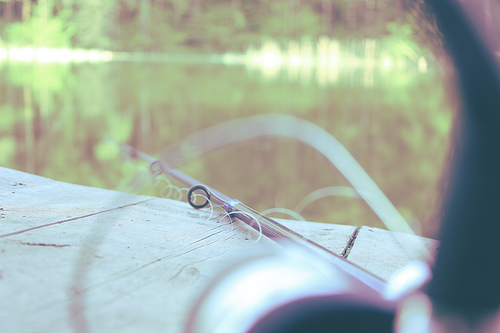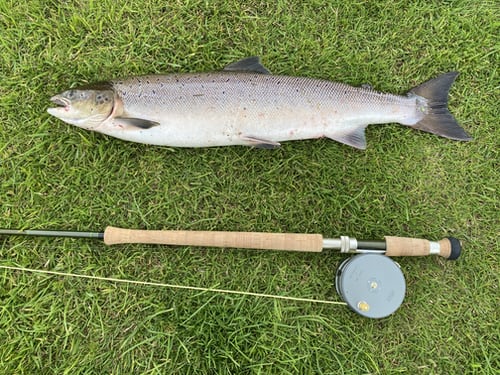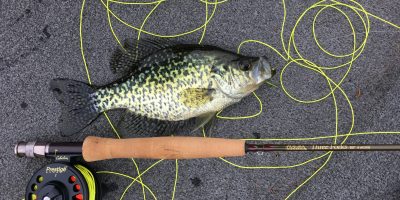If you’ve invested in your fishing gear, you’ll want to know how to store it properly, so you can keep it as good as new for as long as you can. But is there a safer place to store your fishing rods? We know how important your fishing gear is to you, so we figured we’d help you out and give you some advice on storing your fishing rods and keeping them in top condition. Do you know the best way to store fishing rods?
Best Way To Store Fishing Rods

If you love angling, you need to know how important it is to keep your angling gears secure. One of the best angling gears you want to keep safe is your fishing rods and reels. Unfortunately, most anglers do not have the best knowledge of how to store their fishing rods and reels properly.
1. Best Way To Store Fishing Rods: Disassemble The Reels
The first tip is to disassemble a reel. Once you do so, make sure you grease and oil the reels. Identify and repair any worn-out gear or even springs. Once again, clean and grease the handles of the reels and the seat of the reel. It’s necessary to lubricate all of these moving parts. The explanation for this is clear. When you store your reels, the moving parts won’t freeze or get corroded.
2. Best Way To Store Fishing Rods: Check For The Waders For Leak
It’s advisable for guys who use waders to search the waders for leaks. Look out for the pinhole leaks that are the most difficult to locate. A simple way to assess the leak is to get a dark room and then use a flashlight inside the waders. The light from inside the waders is pressed through the pinhole. You can then circle the area and use a waterproof adhesive to patch it. When you patch your waders, you’re going to stop more tears along with the holed up areas.
3. Best Way To Store Fishing Rods: Inspect And Restore The Rods
The next thing you need to do is search the rod for any worn guides. You should also look for signs of worn-out wraps. You should replace them in case you spot them. Look out for guides with nicknames or grooves. The easiest way to patch the loose wraps is to use the extra wrap of the winding thread and then use the lacquer to coat it.
Doing this will prevent any more harm that might occur while your rod is sitting in the garage. Storing good gears minimizes more damage.
4. Best Way To Store Fishing Rods: Store The Fishing Rods Vertically
Another very critical suggestion is to hold the fishing rods in a vertical position. The explanation why this is so advisable is clear. If you store your fishing rods in a vertical position, you can prevent any sort of bending.
5. Best Way To Store Fishing Rods: Clean Lines For Storage
When left to sit on your fishing line for a long time, the water we fish in may also do some damage; that’s why you need to clean the lines. Water also has chemicals that will react to the line and leave you with weak ends.
Until you store it, make sure you clean your fishing line. Doing this will not only extend your life expectancy, it will also give you the best experience. Often use the soap dish when you want to clean your lines.

6. Best Way To Store Fishing Rods: Store At Room Temperature
Besides keeping your rods in a standing position, you should also ensure that they are kept under room temperature. If you do so, it will also keep the rods from bending at all. When you store your rods in hot spots, they can fade quickly together with graphite or fiberglass.
7. Best Way To Store Fishing Rods: Replace Damaged Accessories As Well
Often you can split the lures. In addition to the lures, certain fishing accessories, such as hooks, may also bend and break. You’re expected to make sure you replace all of them. Replacing things like hook hones and hook terminals would allow you to have a fully working hook that you can pick up and head out straight.
8. Best Way To Store Fishing Rods: Remove The Fly Lines Of The Reel
If you are using the fly lines to fish, you should make sure that they are separated from the reels until you store your lines in loose coils. Make sure that the coils are loose, pushed into the coils, stick and harm the lines as you try to separate them. In addition, these types of lines are constructed from memory, which means that storing them in tight coils can easily trigger kinks and tangles along with the spring.
9. Best Way To Store Fishing Rods: Clean And Sharpen
Always sweep, dry and then coat the blade and hooks with light oil to avoid corrosion. This is particularly ideal if you want to store these fishing gears in the cold and freezing winter.
10. Best Way To Store Fishing Rods: Using The Rod Sleeves
In case you have disassembled the fishing rods, it is very important that you use the rod sleeves when you store them. This action will allow you to keep the tip and the butt parts of the fishing rods out of some sort of inconsistency along the way.
Your Complete Fishing Rod Guide

Good fishing is not always fast. For the ideal combination of patience, ability and experience, you need the right conditions. A little luck doesn’t hurt, either. You can’t bite a shark, though. You’ve got to have the right gear to handle it to drive the big one home.
One of the most vital (and obvious) elements of any angler’s equipment list is their fishing rod. These poles allow fishermen to bring their bait and lure into the water with precision, strength and distance as they look for fortune at the end of their line. However, not every rod is designed the same, and some rods might be ideal for some anglers. With these tips and tricks, you will be on the right track to select the right fishing rod for your day on the lake.
Fishing Rod Elements
Before you choose the length and style you like, you should know the various components of your fishing rod. These pieces are mostly universal, with only minor variations depending on the type of the fishing rod.
Handle
Starting from the bottom of your fishing line, the handle is, of course, where you hold the pole. Handles are typically made of cork or EVA foam for secure, sturdy grip and can vary in length. Usually, longer handles are better for longer casting so you can get both hands active for more load. Shorter handles can allow anglers to make shorter casts, cast with one hand, or even master the roll casting technique. Fishermen may also look for split grip, popular with bass anglers, or pistol grip handles, which can help keep the overall weight of the rod down for shorter castings with lighter bait.
Reel Seat
Moving up the rod, you’re going to find the seat of the reel. This is the place where you can rig the reel by slipping the reel foot into the collars, tightening them down to prevent any play or wobble from the setup. Be sure to explore how to pick a fishing reel so that your angling setup can be strong from top to bottom.
The Blank & Guides
The key part of the shaft of your fishing rod is called the blank. Along the blank are the guides, which are the circular bits that are threaded through your fishing line for further power. The guides are made of either plastic, metal, or ceramic materials and are connected to the rod’s bearings. The guides of the fishing rod are on top (facing towards the sky) of casting rods. Guides are on the bottom (facing towards the ground) of spinning rods. The final guide in the series on your rod is the tip, which is the thinnest and most flexible part of the rod.
The Ferrullas
If your rod is collapsible, you’ll have two ferrules: one male and one female. This is where your rod is coming together for proper use. When connecting the two parts, make sure the guides match up, so your line has a straight travel plane.
Choose Rod Length
Now that you know all the basic parts and parts of your fishing rod, you can start to decide which pole is better suited to your fishing style. The rod’s length is measured from the end of the handle to the end of the tip of your rod and can affect your casting abilities greatly. In general, smaller fishing rods lay shorter distances, whereas longer fishing rods lay longer distances. However, each form has a function. In situations where close fighting is required, anglers can profit from the use of a shorter fishing rod. Shorter lengths can also aid in the battle against fish since they often have less bend than other longer alternatives. Longer fishing rods excel in their ability to cast long distances, making them ideal for more water and deep fishing.
The length of the fishing rod usually varies from 6 to 12 feet, so to select a measure for your needs, consider the type of fishing you want to do, the species you are after, and your fishing environment. A decent length for beginner anglers is typically around 7 feet. This size will allow amateurs to have a balanced amount of distance casting and accuracy as they fine-tune their skills through experience.
Form Of Rod Materials
Fishing rods may be made of graphite or fiberglass. Usually, more experienced anglers prefer graphite rods because of their stiffness and combat strength. Their sensitivity will make it much easier to pick up bites. Be conscious, however, that graphite can be more fragile than other alternatives.
Fiberglass is a tougher material choice for fishermen, but the added strength adds extra weight. Beginner fishermen may benefit from fiberglass rods due to their durability and minimal maintenance. Fiberglass is also a common choice for anglers seeking larger, more aggressive species such as muskellunge and pike.
In addition, there are composite solutions that incorporate fiberglass and graphite. If you are an angler who uses a single rod for different conditions, this combination will complement your style.
Consider your skill level and favorite fishing methods to best decide which material can be an advantage to your fishing capability.

Choosing The Form Of Fishing Line
Now that you know how long you want your rod to be and how much strength and action you need in your pole, the last decision you have to make as an angler is what kind of rod you want to use. Fishing rods come in two general types, with variations depending on the species and the environment.
Casting Rods
Casting rods are built with guides on top of the blank and allow fishermen to position their castings more clearly and precisely. They can come in either baitcasting or spincasting models to fit either form of a reel. One of the main variations between the baitcasting rods and the spin-casting rods is the guide scale nearest to the reel’s seat.
Since the fishing line peels off baitcasting reels in a different way, the guide size will be smaller to better fit the direction. There are also trolling rods, which are a much heavier casting-style choice used in deep-sea fishing for extremely large species such as tuna and marlin. These are usually best to use only when hunting these larger game fish.
Spinning Rods
Spinning rods are typically smaller and lighter than their casting counterparts and are built to house spinning rods. While the casting rod guides are positioned at the top of the blank, the spinning rods have the guides at the bottom. This makes it a comfortable, easy-to-use choice for fishermen, particularly beginners and those looking for an ultra-light rod.
There are also saltwater choices called surf rods, which are heavier, longer versions built to hold heavy sinks and larger baits. Surf rods are made for long casts so that saltwater fishermen can get their bait from the beach, pier, or rocks past the surf.
How To Clean A Seawater Fishing Rod

Saltwater fishing rods take a little more care than freshwater rods because saltwater causes more corrosion. That’s what you need to hold in mind. Any time you get back from the saltwater tour, you want to cut some lines from the guides and remove the reel from the rod. Clean your rod with warm freshwater and a mild all-purpose cleaner.
Make sure you clean them thoroughly to ensure that there are no salt deposits. Review the manuals, too. Use a small wire brush to wipe it down. They will easily rust and corrode from saltwater.
A. Clean The Handle Of Your Rod.
This is more for aesthetics, but having a dirty handle will make the rod harder to handle when you combat a larger fish, and if you fish saltwater, the water will take its toll on the handle as well. The easiest way to clean the rod’s handle is to take some alcohol and rub the handle and rinse it off. Follow this phase over and over until it all shines.
B. Take Care Of The Fishing Gear.
Fishing is something that almost everyone can do if you’ve got time, patience, and the right gear. It’s really soothing, and most people try it out and enjoy it. One thing that is really critical when it comes to fishing is your gear and how well you take care of it. Fishing equipment can be pricey, so it’s important to take care of your stuff so it’ll last longer. Here’s how you need to take care of your fishing gear.
C. Make Sure You Store It Correctly.
All have a particular way to store it. You keep the meat properly stored in your refrigerator, keep your medication in a cold, dry spot, so of course, you still need to keep your fishing gear properly stored. Don’t ever keep your rods hot like your trunk. The easiest way to store them vertically is to keep the blanks straight. If you don’t need your poles anytime soon, you can store them in your rod sleeves. These will keep your rods safe from dust and other elements that they can meet while in storage.
D. Clean Your Handles And Hardware.
You would be able to increase your equipment’s lifetime by cleaning the handles and the reel mounting hardware. Soak a towel in rubbing alcohol and wipe your fishing gear down. This is going to leave it looking and smelling brand new. It’s also important to clean your gear when you get it first. There could be dirt and debris on a new handle, and you’re going to want to get it off when you get it.
E. Keep The Guides Tidy.
This is one of the most important things when it comes to keeping up with your fishing gear. Your guide can get a lot of wear and tear over time, so it’s important that you take good care of it. As you fish, minerals and grass will start building on your guide. It’s going to break down faster. It may be tiring to clean up your guide, but it certainly needs to be done. You can get a Q-Tip and some WD-40 or a dish cleaner, and then soak the Q-Tip in whatever liquid you want to use. Take this Q-Tip and rub it all over the guide, inside and out, until it’s absolutely clean. If you want to clean it quickly after you’ve been through fishing, just pour some water on it and wipe it off with an old shirt or rag.
F. Make Sure That You Keep Them Looking Fine.
Keeping your gear in good shape is not only vital for looking good, but it also helps to last longer. One way to make it look better is by cleaning the blank off with a healthy cleaner a couple of times during the year. Not only does this make it look better, but it will also help to repel water.
G. Evite The Moisture.
While fishing takes place in the sea, water can cause a lot of problems for your equipment. You can make sure that you let the air out of your box so that it can dry out and prevent mildew. After you get in from fishing, you can run a low-heat blow dryer around your pole so you can be sure it’s fully dry.
H. Know When You Want To Replace Them.
Rods aren’t made to last forever. There will be a time when they will become frail and need to be replaced. They’re going to get soft, and they’re not going to be able to carry weight like they did when they were new. This is how all the brands are, so remember, after a few years, that you’re going to have to repair your poles.
Final Words
If you store your fishing rods properly, you can help to prolong the life of your rods, reels, and lines. If you store your rods vertically or horizontally, with or without the reels attached, remember to make sure you wash them down and dry them out before you put them away. Any angler who wants to learn the best way to store fishing rods should start with these basic tips. They’re easy to learn, and they’re easy to practice. Over time, you will find that they simply fall into place.


